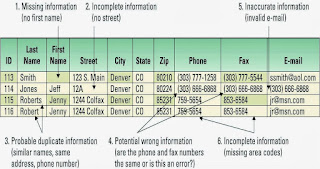1. Learning Outcomes
1.1 Describe the broad levels, formats and granularities of information
1.2 Differentiate between transactional and analytical information
1.3 List, describe and provide an example of each of the five characteristic of high quality information
1.4 Assess the impact of low quality information on an organization and the benefits of high quality information on an organization
2. Organization Information
> Information is everywhere in an organization
> Employees must be able to obtain and analyze the many different levels, formats and granularities of organizational information to make decisions
> successfully collecting, compiling, sorting and analyzing information can provide tremendous insight how an organization is performing
> Level, format and granularities of organizational information
3. The Value of Transactional and Analytical information
- Transactional information verses analytical information
Transactional Information - routine activities, single business process
Analytical Information - to support analysis task, easy to top level making decision in a organization
- Timeliness is an aspect of information that depends on the situation
- Real-time systems - provides real-time information in response to query requests
Exp : all, first information to us, updated the information
- Business decisions are only as good as the quality of the information used to make the decisions
- You never want to find yourself using technology to help you make a bad decision faster
> Characteristics of high-quality information include :
- Accuracy - Are the values correct? For example, is the name spelled correctly? Is the dollar amount recorded properly?
- Consistency - Is aggregate or summary information in agreement with detailed information? For example, do all total fields equal the true total of the individual fiends?
- Uniqueness - Is each transaction, entity and event represented only once in the information? For example, are there any duplicate customers?
- Timeliness - Is the information current with respect to the business requirements? For example, is information updated weekly, daily or hourly?
4. The Value of Quality Information
> The four primary sources of low quality information include :
- Online customers inaccurate information to protect their privacy
- Different systems have different entry standards and formats
- Call center operations enter abbreviated or erroneous information by accident or to save time
- Third party and external contains inconsistencies, inaccuracies and errors
> Potential business effect resulting from low quality information include :
- Inability to accurately track customers
- Difficulty identifying valuable customers
- Inability to identify selling opportunities
- Marketing to nonexistent customers
- Difficulty tracking revenue due to inaccurate invoices
- Inability to build strong customer relationship
6. Understanding the Benefits of Good Information
> High quality information can significantly improve the chances of making a good decision





No comments:
Post a Comment